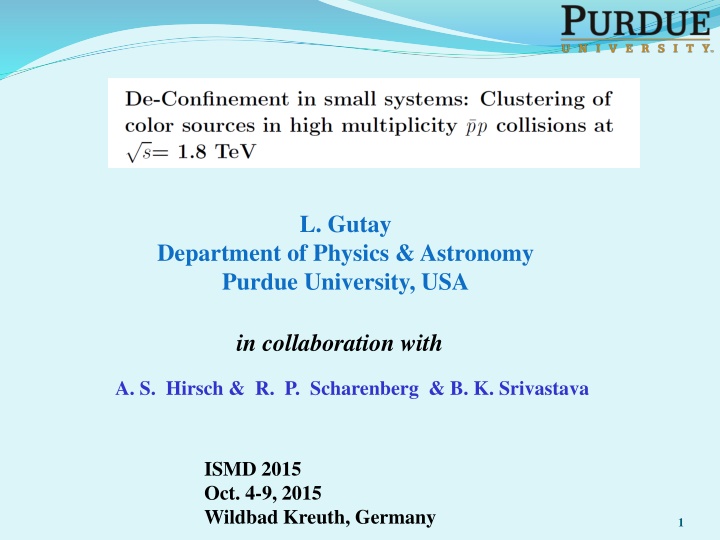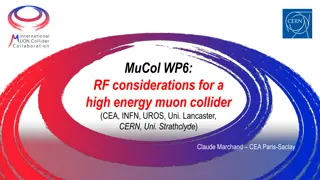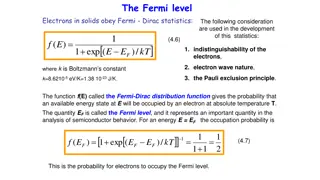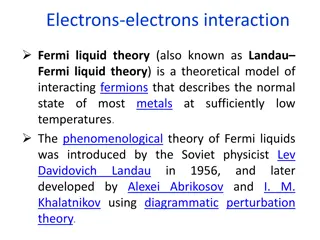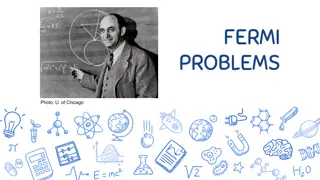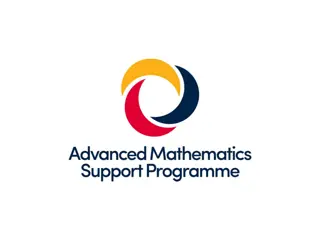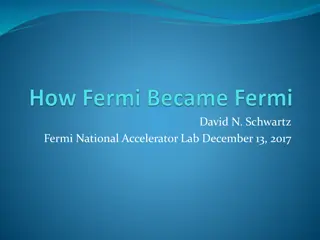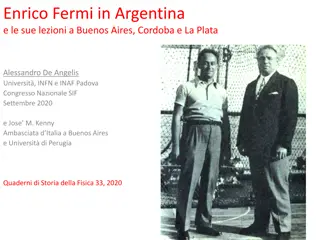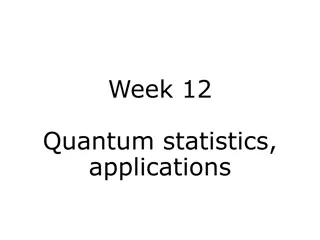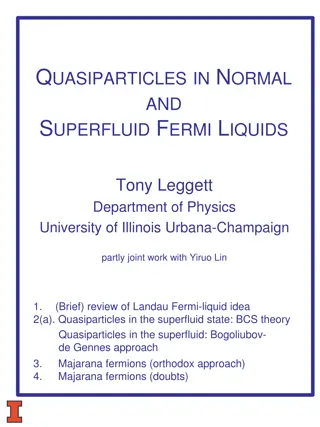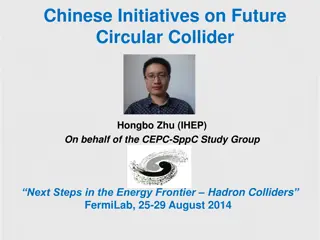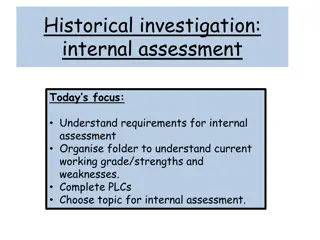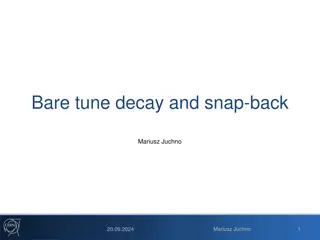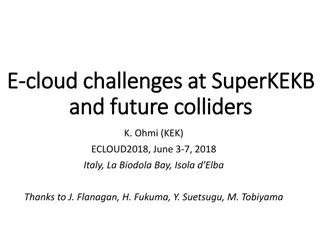Investigation of QGP Formation at Fermi Lab CO Collider
Investigation led by L. Gutay at Purdue University, in collaboration with other researchers, presented evidence for de-confinement in high-energy collisions. The E-735 experiment at 1.8 TeV utilized advanced detectors and percolation theory to analyze multiparticle production, showcasing a potential phase transition similar to percolation phenomena. The study explored color strings and percolation effects on particle clustering, shedding light on the transition from hadronic to partonic matter. The results were compared with lattice QCD simulations, revealing valuable insights into QGP formation dynamics.
Download Presentation

Please find below an Image/Link to download the presentation.
The content on the website is provided AS IS for your information and personal use only. It may not be sold, licensed, or shared on other websites without obtaining consent from the author.If you encounter any issues during the download, it is possible that the publisher has removed the file from their server.
You are allowed to download the files provided on this website for personal or commercial use, subject to the condition that they are used lawfully. All files are the property of their respective owners.
The content on the website is provided AS IS for your information and personal use only. It may not be sold, licensed, or shared on other websites without obtaining consent from the author.
E N D
Presentation Transcript
L. Gutay Department of Physics & Astronomy Purdue University, USA in collaboration with A. S. Hirsch & R. P. Scharenberg & B. K. Srivastava ISMD 2015 Oct. 4-9, 2015 Wildbad Kreuth, Germany 1
Proposal to search for QGP at the Fermi Lab CO Collider The experiment was accepted as E-735 in 1983 pp At 1.8 TeV The Detector consisted of : Scintillator vertex hodoscope A Side arm magnetic spectrometer A time of flight system for particle identification 2
E-735 Measurements dn d Temperature as a function of Length of multiplicity involved p Particle identity : , K, p, , d, Freeze-out energy density Conclusion: Evidence for de-confinement was published in 2002. The comparison was Made with Lattice QCD calculations. Phys. Lett. B528, 43 (2002). Here we present the results which come from reanalysis of the E-735 data using Color String Percolation Model. The results are also compared with with Lattice QCD simulations. 3
Percolation : General It is well known that the percolation problem on a large lattice displays the features of a system undergoing a second-order phase transition. For example: * Transition from liquid to gas * Normal conductor to a superconductor * Paramagnet to ferromagnet 1. 2. H. E. Stanley , Introduction to Phase Transitions and Critical Phenomena D. Stauffer and A. Aharony, Introduction to Percolation Theory 4
Parton Percolation Multiparticle production at high energies is currently described in terms of color strings stretched between the projectile and target. Hadronizing these strings produces the observed hadrons. The no. of strings grow with energy and the no. of participating nuclei and one expects that interaction between strings becomes essential. Clustering of Color Sources De-confinement is thus related to cluster formation very much similar to cluster formation in percolation theory Critical Percolation Density c = 1.20 5
Color Strings + Percolation = CSPM Multiplicity and <pT2 > of particles produced by a cluster of n strings Multiplicity ( n) ( n F = Average Transverse Momentum 2 T 2 T s = / ( ) p p F ) N 1 n 1 s N S 1 = 1 e S = Color suppression factor (due to overlapping of discs). N ( = ) F Ns = # of strings S1 = disc area SN = total nuclear overlap area is the percolation density parameter. Complete description of CSPM has been published in Phys. Rep. Sept. 2015 Braun, Deus, Hirsch, Pajares, Scharenberg, Srivastava 6
Data Analysis Using the pT spectrum to calculate The experimental pT distribution from pp data is used 2 2 d N dp d N a + = 2 t 2 n ( ) dp p p 0 t t a, p0 and n are parameters fit to the data. Charged Hadron spectrum This parameterization can be used for nucleus-nucleus collisions to account for the clustering : pt GeV/c F = ( ) 0.57 AuAu 2 d N b F = ( ) 1 = For central collisions 2 n pp dp ( ) F F + t pp p p 0 t ( ) AuA u 7
Schwinger Mechanism of Particle Production pt distribution of the produced quarks dn d p 2 t p ~ exp( ) k is the string tension 2 k t The tension of the macroscopic cluster fluctuates around its mean value because the chromoelectric field is not constant . Assuming a Gaussian form for these fluctuations one arrives at the probability distribution of transverse momentum. p dn d p ~ exp( ) t Thermal Distribution 2 T t Cluster /Initial Temperature k 2 t p = T = 1 T 2 2 ( ) F 9
Temperature The connectivity or percolation threshold for the formation of the spanning cluster occurs when the string density is = 1.2. 2 t p = 1 T 2 ( ) F F( ) at =1.2 and the Universal Hadronization Temperature T = 167 2.2 MeV are used to accurately calibrate the T( ) scale. This accurately determines the single string momentum. < pt2 >1 = 207.2 3.3 MeV. PHENIX: Temperature from direct photon Exponential (consistent with thermal) Inverse slope = 220 20 MeV PRL 104, 132301 (2010) CSPM result: For Au+Au@ 200 GeV ( STAR data) 0-10% centrality = 2.88 T ~ 195 MeV ALICE : Direct Photon Measurement T = 304 51 MeV, QM 2012 Pb+Pb @ 2.76TeV for 0-5% T ~265 MeV 10
Energy Density Bjorken 1D expansion dN m 3 1 3 c t = / GeV fm 2 dy A pro Transverse overlap area Proper Time is the QED production time for a boson which can be scaled from QED to QCD and is given by 405 . 2 pro = pro m t J. Dias de Deus, A. S. Hirsch, C. Pajares , R. P. Scharenberg , B. K. Srivastava Eur. Phys. J. C 72, 2123 ( 2012) Introduction to high energy heavy ion collisions C. Y. Wong 12
Having determined the initial temperature of the system from the data one would like to obtain the following quantities to understand the properties of QCD matter 4 /T Shear Viscosity Equation of State 13
The viscosity can be estimated from kinetic theory to be 4 1 ( ) 15 5 3 ( ) 4 1 ( ) tr n T s Hirano & Gyulassy, Nucl. Phys. A769, 71(2006) ( ) ( ) n T T s T T Energy density s Entropy density n the number density Mean free path Transport cross section Average transverse momentum of the single string mfp tr = T Ts mfp tr = tr 2 1 tp mfp 5 L is Longitudinal extension of the source 1 fm 1 L L = T mfp 1 e 5 s 1 e 15
Trace Anomaly COMPARE the trace anomaly Ansatz ( /S)-1= S/ with the trace anomaly from hot QCD (T) =( -3p)/T4 S/ (T) and (T) have the same magnitude and temperature dependence. Ansatz: we will use S/ (T) to correlate (T) and p(T) for T>TC 17
Sound Velocity 3p / dp d dp p = = = + 2 s C 4 T d + 0.0191( / 3) e 1 e 1 e (1 e ) 1 2= ( 0.33) 2 CS 1 e 18
Summary The p p collisions at s = 1.8 TeV from the E735 experiment have been re-analyzed in using the clustering of color sources data based phenomenology. The Percolation framework provide us with a microscopic partonic structure which explains the early thermalization. The Bjorken ideal fluid description of the QGP , when modified by the color reduction factor and the trace anomaly represented by s/ is in remarkable agreement with the Lattice Quantum Chromo Dynamics(LQCD) simulations. These results prove that even in small systems at high energy and high multiplicity events , QGP formation is possible as seen in collisions at s= 1.8 TeV. pp A further definitive test of clustering phenomena can be made at LHC energies by comparing h-h and A-A collisions. 19
References 1. To appear in Phys. Rep. ( Sept. 2015)* De-Confinement and clustering of color sources in nuclear collisions 2. Eur. Phys. J. C 72, 2123 (2012)** Clustering of Color sources and shear viscosity to entropy density 3. Eur. Phys. J. C 71, 1510 (2011)*** Percolation of color sources and the equation of state of QGP . 4. R. P. Scharenberg , CPOD 2013, 017 (2013) The QGP EOS by measuring the color suppression factor at RHIC and LHC 5. B. K. Srivastava , Nucl. Phys. A926, 142(2014) Percolation approach to initial stage effects in high energy collisions * Braun, Deus, Hirsch, Pajares, Scharenberg and Srivastava ** Deus, Hirsch, Pajares, Scharenberg and Srivastava *** Scharenberg, Srivastava and Hirsch 20
